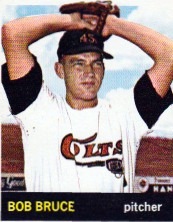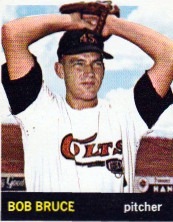September 27, 1964: Extra-inning pitchers’ duel closes Colt Stadium in style

Few major-league ballparks of the modern era seem less celebrated than Houston’s Colt Stadium, a single-decked, roofless park that saw use for only three seasons.1 Colt Stadium was always meant to be temporary,2 just a stopgap to last until the completion of the Astrodome – the “Eighth Wonder of the World” – a ballpark whose grandeur, glamour and innovation permanently overshadowed its modest predecessor.
If Colt Stadium is remembered for anything, it’s probably the searing Texas heat and the stinging mosquitoes. The Associated Press reported in June 1962 that Colt Stadium was the first major-league park to sell insect repellent at its concession stands,3 while the Mets’ Richie Ashburn was widely quoted as calling Houston “the only city in the country where the women wear insect repellent instead of perfume.”4 The publicity from these and other stories helped to permanently link the ballpark and its bugs in the minds of fans everywhere.
That said, Colt Stadium was the place where baseball-loving Houstonians first made the acquaintance of major-league baseball, and a place where they got to see some memorable games. That included the very last game ever played at the ballpark, an extra-inning Dodgers-Colts pitching duel played on Sunday afternoon, September 27, 1964.5
Only 6,246 fans turned out for the game, in a ballpark built to handle 33,000. Clearly, the chance to say goodbye to Colt Stadium was not a major draw. But that wasn’t the only explanation for the low turnout. For one thing, the home team was well on its way to a second straight ninth-place finish, with a poor 64-91 record. The team’s performance had cost founding Colts manager Harry Craft his job less than two weeks earlier.6 For another, the visiting Dodgers – a National League powerhouse for most of the early ’60s – were also having a lousy year. Walter Alston’s club sat in in seventh place with a 76-78 record, with injuries, age, and poor hitting and defense all contributing to the slide.7 The Dodgers had lost six of their previous 10 games.
Finally, the city of Houston suffered through an outbreak of mosquito-borne encephalitis in the late summer of 1964. As of a few days before game time, the outbreak was being blamed for 32 deaths and about 700 cases of illness.8 Given Colt Stadium’s reputation for bugginess, even devoted baseball fans might have perceived a health risk in spending time there. For the season as a whole, the Colts drew the worst attendance in the National League: 725,773 for 81 home dates, or fewer than 9,000 people per game.
Though neither team had anything to play for, both Alston and Colts manager Lum Harris mostly filled their starting lineups with players who had played regularly or semi-regularly during the season, leaving their September call-ups on the bench. An exception on the Dodgers’ side was third baseman Bart Shirley, playing his 11th big-league game. Future Hall of Fame second baseman Joe Morgan was a similar exception for Houston, playing only his seventh major-league game of 1964 and the 15th of his career. Don Drysdale (18-15, 2.19 ERA) got the start on the mound for Los Angeles, while Bob Bruce (14-9, 2.93 in the best season of his career) got the start for Houston.
One other future Hall of Famer, in the winter of his career, merits mention. Second-base umpire Jocko Conlan had already announced his intent to retire at the end of 1964, wrapping up a distinguished professional playing and umpiring career that began in 1920.9 After September 27, Conlan was scheduled to work only six more games before hanging up his trademark chest protector. As it happened, the National League recruited Conlan to come back for 17 more games in May and June 1965 to cover for another umpire’s illness. Those would be his final appearances.10
Drysdale and Bruce got off to torrid starts. Through the first four innings, the only baserunners on either side came from a pair of Dodgers singles – Dick Tracewski in the first, Nate Oliver in the second. Both were forced out at second to end their respective innings. Meanwhile, the first 12 Colts went down in order. Drysdale was not overpowering – there were no strikeouts in the first four innings – but he was effective. One writer noted at game’s end that 27 batters on both sides were retired on fly balls, though most were popups.11
Los Angeles threatened in the top of the fifth. First baseman Ron Fairly reached base on an error by his opposite number, Walt Bond. Oliver sacrificed Fairly to second and Bruce wild-pitched him to third. Shirley lined out to center fielder Jim Wynn, not deep enough to score Fairly, for out number two. Up came pitcher Drysdale, who began the day hitting .179 – and Bruce walked him to prolong the inning. Tracewski could only muster a groundball to shortstop Eddie Kasko, though, and Drysdale was forced out at second to end the threat.
The Colts’ offense showed signs of stirring in the fifth and sixth innings. Wynn drew a two-out walk in the fifth, but his tenure as the team’s first baserunner didn’t last long; Dodgers catcher John Roseboro threw him out trying to steal second. In the sixth, catcher Jerry Grote reached on an error by second baseman Oliver and left fielder Al Spangler singled him to second. But the rally stalled when Morgan grounded out to Tracewski.
Things simmered down after that, as Drysdale and Bruce continued to dominate – until the ninth, when both teams squandered chances. In the top half of the inning, left fielder Tommy Davis doubled to right field with two out. Roseboro reached when Morgan mishandled his groundball, but when Davis tried to score on the error, Morgan recovered and threw him out at home.12 In the bottom half, the Colts had runners on first and second with one out on singles by Bruce and Morgan. But right fielder Rusty Staub, who wore an 0-for-5 horse collar this day, grounded into a 4-6-3 double play to send the game to extra innings. Through the regulation nine innings, each team had mustered exactly three hits, one walk, and zero runs.
The 10th and 11th innings passed largely uneventfully, with each team putting a single runner on first but not advancing him. Ron Perranoski, the Dodgers’ ace reliever of the early 1960s, took over in the 11th inning, while Bruce continued to labor for the Colts. In the top of the 12th, it looked as if the Dodgers might finally be catching up with Bruce. With two out, Roseboro singled and Fairly walked. Oliver ended the threat, though, by grounding out to Morgan at second.
Those fans who hadn’t been chased away by mosquitoes or called away by other commitments finally got to see the last rally in Colt Stadium history in the bottom of the 12th. Morgan led off with a legged-out single, as Perranoski failed to cover first.13 Staub tried to sacrifice Morgan to second, but replacement Dodgers third baseman Jim Gilliam threw to second to retire Morgan. Bond grounded to Perranoski for the second out, with Staub advancing to second. Perranoski intentionally walked third baseman Bob Aspromonte to pitch to Wynn, and Wynn made him pay with a run-scoring single to left field, grounded “fair by inches” past third base.14
After 2 hours and 50 minutes, Bruce had earned the win with 12 innings of five-hit shutout ball, while Perranoski took the loss. Bruce, who at that point had worked 22 scoreless innings against Los Angeles, became the first Colt .45s pitcher to reach 15 wins in a season.15 Drysdale, meanwhile, had pitched 23 innings without the Dodgers scoring a run to support him.16 After the game, children ran the bases as part of a Family Day promotion, a high-school band played “Auld Lang Syne,” and the ballpark announcer told fans that the team would see them in “the domed stadium” next April.17 That prediction came to pass, and for the most part, Houston’s baseball fans haven’t looked back since.18
Sources
In addition to the sources cited in the Notes, I used the Baseball-Reference.com and Retrosheet.org websites for general player, team and season data and the box scores for this game:
baseball-reference.com/boxes/HOU/HOU196409270.shtml
retrosheet.org/boxesetc/1964/B09270HOU1964.htm
Image (1964 Topps #282) downloaded from the Trading Card Database.
Notes
1 1962 to 1964.
2 Frank Finch, “Colts’ Outfield Quite a Spread,” Los Angeles Times, February 4, 1962: H5.
3 Associated Press, “Colts Stung by Defeat; NY Bitten,” Austin (Texas) American-Statesman, June 12, 1962: 16. While reputation sometimes outpaces reality with this kind of grumble, a review of news articles about mosquitoes and Colt Stadium suggests that athletes, reporters, and fans had legitimate reason to complain.
4 Lou Smith, “Reds Blowing Close Ones,” Cincinnati Enquirer, July 1, 1962: 4E.
5 This was also the last game played under the Colt .45s name: The team rebranded to the Astros as it moved into the new domed stadium for the 1965 season. The team has since worn replica Colt .45s jerseys in twenty-first-century Turn Back the Clock games.
6 Associated Press, “Houston’s Harry Craft 1st Manager to Be Fired,” Lansing (Michigan) State Journal, September 20, 1964: H2.
7 Bob Hunter, “Three Flies in Dodgers’ Soup – Weak Bats, Injuries and Errors,” The Sporting News, October 3, 1964: 2.
8 Associated Press, “Houstonian Dies from Encephalitis,” Austin American, September 24, 1964: 35.
9 Jerome Holtzman, “Chi Opens Heart for Long-time Favorite Jocko,” The Sporting News, September 26, 1964: 21. This article mentions Conlan’s declaration of retirement in the context of ceremonies held in his honor at Wrigley Field on September 13.
10 Rodney Johnson, “Jocko Conlan,” SABR Biography Project. Accessed September 18, 2020.
11 Fred Hartman, “Bruce Beats LA, 1-0,” Baytown (Texas) Sun, September 28, 1964: 9.
12 United Press International, “Drysdale Gets No Bat Help, Dodgers Bow, Return Home,” Progress-Bulletin (Pomona, California), September 28, 1964: 2, 7.
13 George Lederer, “Drysdale Remains Runless,” Long Beach (California) Independent, September 28, 1964: C2.
14 Hartman.
15 United Press International, “Dodgers Have a Nemesis: Bruce Shuts ’Em Out in 12,” Los Angeles Times, September 28, 1964: III, 3.
16 Lederer.
17 Hartman.
18 Colt Stadium was subsequently sold, broken down, and reassembled for new use in Torreon, Mexico. See Ron Cook, “In Houston, the Weather Was Bad, the Mosquitoes Were Worse,” Pittsburgh Press, May 11, 1986: D3.
Additional Stats
Houston Colt .45s 1
Los Angeles Dodgers 0
12 innings
Colt Stadium
Houston, TX
Box Score + PBP:
Corrections? Additions?
If you can help us improve this game story, contact us.


